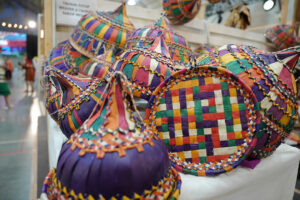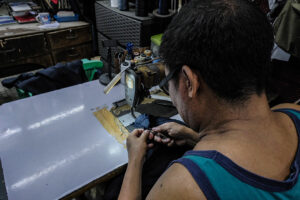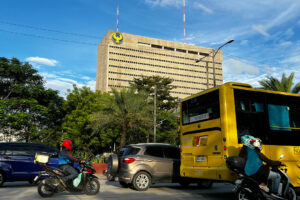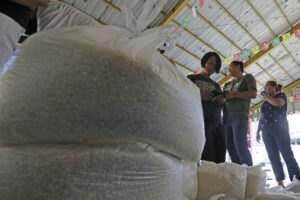By Joseph L. Garcia, Senior Reporter
HOW many times do you get several National Living Treasures in one room, and actually hold in your hands what they make?
This is, we believe, the crowning glory of Likha 3, the third iteration of Likha, a project spearheaded by the Office of the First Lady, Liza Araneta Marcos. The project was aimed to bring together just weavers in February 2023, according to Deputy Social Secretary Dina Arroyo Tantoco. The weavers attended workshops and were given free space to showcase their goods. The reception was so great that they decided to hold a second one a few months later, in June, to coincide with Independence Day on June 12.
“It’s actually the biggest one so far,” said Ms. Arroyo Tantoco about the third iteration. “I think that system has been perfected.”
There are over 80 exhibitors, spread over three sections at the Philippine International Convention Center (PICC) Forum. Section 1 is devoted to newcomers, while Section 2 is filled with graduates of the first two Likha programs. “You can see the difference from the first Likha to now. They have more merchandise, more products. You can tell that they’re really learning from this whole experience,” said Ms. Arroyo Tantoco
Section 3, meanwhile, is for more established brands that work with local communities (there’s Artefino’s Hearte Fino, as well as representation from Habi). Other exhibitors include government agencies that provide help to small businesses, and, of course, a special section devoted to Gamaba (Gawad sa Manlilikha ng Bayan) awardees, deemed National Living Treasures, as recognized by the National Commission for Culture and the Arts (NCCA). These include Abina Coguit for Agusan Manobo Embroidery, Estelita Bantilan for Blaan Mat Weaving, Marife Ganahon for Higaonon Mat Weaving, Magdalena Gamayo for Ilocano Textile Weaving, Teofilo Garcia for Katukong Ilocano (Gourd Hat) Making, Bundos Fara for T’Boli Brass Casting, and Barbara Ofong for T’Boli Textile Weaving.
“I think it’s really just to give a chance for people here to meet them directly,” said Ms. Arroyo Tantoco. “I would never have met these Gamaba awardees. It’s our culture, our craft — they are national treasures.”
Co-organizer designer Lenora Cabili said that projects like these help preserve craft for generations to come. “The preservation starts there. It’s the awareness that it actually exists,” she said, while she stood near the WUTHLE (Women United Through Handcrafted Lace and Embroidery) booth. Had we not spotted Ms. Cabili there, we would not have known that there was a community of handmade bobbin lacemakers in Iloilo, first taught by Belgian nuns. “When the awareness happens, I think that’s when people will start buying. That’s one way of preserving it.”
She continued: “There’s just a lot that needs to be done, especially when you want to utilize culture through craft, as a way to build the identity of the Filipino. Craft really plays a central role.” Likha co-organizer Al Valenciano added, “And it goes down to agriculture. A lot of the things they make are from the land.”
A problem with cultural preservation is that, if judging by the age of the Gamaba awardees, there’s a certain chance that traditional crafts will just die with the old guard. The indigenous communities to which these traditions belong get smaller as younger people move to the cities for better pay. Luckily, some hold on. At the T’Boli Textile Weaving booth to be occupied by Ms. Ofong, a younger relative, Ian Christopher Ofong, was there to talk about the craft. There are more than 30 steps to make a yard of fabric, patterns gathered from dreams, and woven for four to six months, he explained. He himself was wearing a jacket made from T’nalak. “Ito iyong identity namin (this is our identity),” he said, asked about the importance of preserving the craft for people his age (he’s in his 20s). For him, a way to encourage young people to pick up their traditional crafts is through recognition: “Kapag marunong silang gumawa ng T’nalak, kilala sila, not just in the Philippines but in the whole world.”
Mr. Valenciano agrees: “The fact that they’re here, when they go here, they’ll be so proud and tell the community: ‘Importante pala ang ginagawa nila (it turns out that what they’re doing is so important).’”
Recognition, yes; but ascribing value (financial and otherwise), is just as important. Ms. Cabili says. “When it’s craft, the value is in the way it’s created. When you look at the process of the craft, there has to be an appreciation, and put a proper value into what they’ve created. It comes at a price.”
“The younger generation would be encouraged, that it’s a career that they can get into. That’s the cycle that needs to be encouraged,” she said.
Likha 3 is now open to the public until June 11 at the PICC Forum, CCP Complex, Pasay City.





